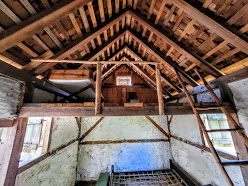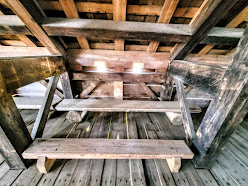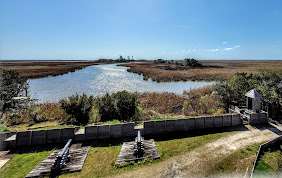Here we are in Georgia. We only made one stop in Georgia this trip. We stayed at a private campground in Belle Bluff, Georgia, and it will not happen again.
This was a part of the road leading to the campground. Can you see the little light square patch... that is where we made our turn... the oak trees have created an arch over the road. After that turn we still had another couple of miles to go.
I chose this campground without doing good research; the military campgrounds were all booked up.
In its day this might have been a great campground. All the sites are sand, and really close together. The campground was not designed for RVs with slides. The campground was also a marina in its early days, sitting on Blackbeard Creek. In the early days, boaters couldlower their boats into the water via a rail and lift system, now it is all just rust. The gentleman that owns the property is doing his best to maintain the 40 acres he owns, but there is a lot to care for.
The biggest torture were the mosquitoes and gnats... the biting kind. Carol and I got eaten alive by these little beasts. I turnedon the bug light in the house, and this is the result of a night burning our bug light.
We decided to make something of our stay though. We needed to do some drivin', just to get to a Walmart or grocery store.
One site close to the campground was the cemetery of the McIntosh family, who arrived in America from Scotland, in 1736.
On another "short" drive, we headed to Darien, to visit Fort King George. The land the fort was built on has much more history than just the fort. On the "lower bluff" the history goes back 4,000 years to the Guale Indians. On top of their existence is the history of Spanish missionaries of the 16th and 17th centuries; the garrison soldiers of the 1721 British outpost; Oglethorpe's Highlanders of 1736; finally a layer from the 19th and 20th century sawmills.
More can be learned at: https://gastateparks.org/FortKingGeorge.
The visit starts off in the museum which timelines the history of the area. The Indians were doing fine until the Spanish arrived around 1526. This was the first visit from the Europeans, the Vikings made it to North American way before the Europeans. Anyway, the Spanish reportedly set up a colony near Sapelo Sound (close to current day Belle Bluff).
The Spanish wasted no time building a mission, which was located on the current Fort King George State Historic Site. This is where the Spanish began their effort to change a culture, moving the Guale from their hunting and fishing ways, to one of agriculture. Unfortunately by 1597, the change did not sit well with the Guale, and they rebelled, killing Spanish soldiers. The Spanish response was to burn the mission to the ground... kind of like cutting off your nose to spite your face... it changes the situation, but didn't fix it.
Lets look at the "poor" English colonists in the area. In 1670, Jolly Old England has the Chichimeco Indians attack and drive some of the Guale Indians south to Florida where the Spanish welcome them, others move northward to South Carolina, and the loving arms of the English.
1686 sees a remnant of Guale Indians cross the Savannah River to form a new Indian nation, The Yamasee Nation. The Yamasee nation sided with the Spanish. The Spanish and Yamasee raided Port Royal, killing a few of the Scots living there, and continuing inland, destroying plantations. They had their eyes on Charles Town (Charleston) as well, but mother nature had other ideas, sending in a hurricane that wrecked several Spanish vessels.
1715 saw some of the bloodiest fighting between the Indians and colonists. The Yamasee were driven south... where the Spaniards eagerly welcomed them.
This is where we see the concept of Fort King George grow. In 1720, a guy named Colonel John Barnwell, a South Carolina planter and Indian fighter, petitioned England to build a fort in the area to protect against Spanish and French expansion.
In 1721, the British Board of Trade approves the petition, sending Scotsmen, carpenters, sawyers, and slaves to build a fort.Before we run out to the fort, lets finish the museum.
The fort is completed by 1721, and is the oldest English fort on the eastern seaboard, garrisoned with English soldiers. The fort was garrisoned for six years. During that time the lives of 140 men were lost. These troops died for multiple reasons, ranging from malnutrition to Indian skirmishes. The winter of 1725 was bad on the garrison, the fort burn to the ground. An investigation was conducted which came up with two conclusions, it did not appear to be arson, and it appeared that the men were not motivated to put the fire out. The ramifications for their actions... several week wait for new uniforms and construction of new barracks.
You might be asking yourself why I would have a picture of a pretty lady in a story about a fort... here's why.
Miss Bessie Lewis was a young lady from Ohio who became interested in the rich history of the site surrounding the fort. She was the editor of the local newspaper in Darien, and an english teacher. Bessie's writing examined the fort itself, the Scottish Highlanders, slavery, and history of the locals. Through her research she was able to pinpoint the exact location of the fort, and convinced the Georgia State Parks Department to purchase the land where the fort was located.
With the purchase of the land in 1940, archeological digs began, and they revealed old Indian dwellings and graves of some of the soldiers. In 1952 they find evidence of the Spanish mission; in 1961 the site is deeded to the Georgia Historical Commission; 1965 there is funding in place to build a museum.
Time to step on the grounds of the fort and sawmills. The hike through the site is also a nature walk.
This is the remains of one of the sawmills. The first mills were manual labor with two men on a saw. The log would be brought over a pit, and one man would be standing at the top of the pit, the other in the pit, and they would draw the saw up and down. We will pass a new version later in the hike.
For all you lovers of movies showing the South, you have seen this stuff hanging from the trees, that would be "Spanish Moss". Spanish moss isn't really a moss, but an air plant associated with, get this... the pineapple family. When driving through the South it is evident that this "moss" hangs mostly on oak and cypress trees, and is a lovely nesting material for the birds.
As we wound our way down the nature trail, we came across the reconstructed Highlanders cottage.This cottage was built in the similar way that the Scots would have built it, using the wattle-and-daub technique.
Lattice strips are woven together, then daubed over with some type of sticky material. That sticky material was usually some combination of wet soil, clay, sand, animal dung and straw. As you may see, the cottage has a loft for sleeping or storage, the ground was family space, as well as sleeping quarters... one could go to bed with the sweet smells of bacon over the bed.
Smartly marching on we came across an old tree that had a mind of its own. This live oak decided to lean to the water. My guess wouldbe a hurricane passed by during its younger days, and adjusted the tree's attitude. These trees generally grow to a height of 50 feet, and their limbs will reach out 100 feet.
FUN FACT: there are over 2,000 species of mosquitoes, from the Artic to the Tropics; female mosquitoes are the only ones that buzz and bite.
The nature trail leads to the fort. Entering the fort visitors would havebeen stopped by the sentry on duty, before he would have opened the gate.
That would not have been my idea of a great watch station to be at for four hours in the cold nights, with the wind blowing in off the water. These shacks were at all corners of the fort. Once we were allowed to enter, an adventure awaits. Carol and I entered through the back gate.
These buildings were a lean-to hut on one side, used here for covering a cannon, the blacksmith shop, a woodshop, and another lean-to hut.
As we circle around we come to the all important meeting facility in the fort... the privy. This privy was for single person meetings, other forts were multiple. There was definitely some thought when designing the fort. I say this because soldiers could safely take care of business, protected by two cannons, one on each side.
Here was the home to the garrison enlisted soldiers. I always find it exciting when I could camp out with 40 other people in a space designed for 10; notice the comfortable sleeping.The barracks also housed the cooking facilities for the enlisted. As you might see, the kitchen included the wood necessary to cook, and the dining room table to seat those soldiers able to eat before watch.
As with all military installations, officers are segregated from the working class... oops, I mean enlisted. Yes I have met some good officers, but I am biased, having been enlisted. Anyway, lets take a look at the officer's quarters.Obviously the officer's quarters were smaller, they had fewer officers. Believe it or not, their quarters were not much different than the enlisted, except their furnishings were a bit more luxurious. They also had someone cook for them, unlike the enlisted, who probably rotated in the cooking duties.
These soldiers were not here for a vacation, they were here to protect the interests of the king of England and it subjects. One way they did this was fighting from the blockhouse.The blockhouse (26 feet square) was where a good firefight could have taken place. This multiple level building, one floor for firing cannons, another for the men to fire their rifles, the basement held prisoners and gun powder, and the upper level was an observation deck.
Great view of the river from the observation deck. I didn't take a picture of the holes in the floor of the shooting gallery, but they were intentional. The holes were put in the floor so the soldiers could fire on anyone that was able to make their way the the blockhouse.Leaving the fort, visitors walk past the ruins of the once busy sawmills. This area in its early days was a hot bed for the lumber industry, which lasted until the early 1900s, when the lack of large trees were no longer available.
The sawmills began with South Carolinians cutting 3" thick planks to built Fort King George. Somewhere around 1736 indentured servants of the Scottish Highlanders set up saw pits to cut wood. The lumber they cut was used for homes in Darien, and public businesses in Savannah and Frederica. These saw pits would have utilized the two man teams.
Eventual sawmills were modernized, using the natural resources of the water, allowing a different way to cut the wood. The sawmills ran
on water, which was stored in large basins; when the tide came in, the basins filled turning a paddle wheel. The paddle wheel then turned a sawblade like the one in the picture. This is one that was found on site during archeological excavations. 1818 saw another move in modernization... steam. The Darien Eastern Steam Sawmill continued to cut lumber until 1905, with few interruptions. It saw the end of the lumbering era for the region.
If you remember, earlier I mentioned there were many deaths here for various reasons... visitors can visit some of the grave sites still on premise. The markers only indicate the remains of English soldiers that were laid to rest.
One last place to visit her onsite was the old Spanish mission. The mission was built in the efforts to make the "heathen savages", Christians. Like most older construction, it was made from Abby material (sand and shells).
We returned to our starting point, the museum/gift shop. What would this stop be if I didn't get us a pin from the adventure. I will say that for a small historic site, there was a lot to gaze upon.




































No comments:
Post a Comment